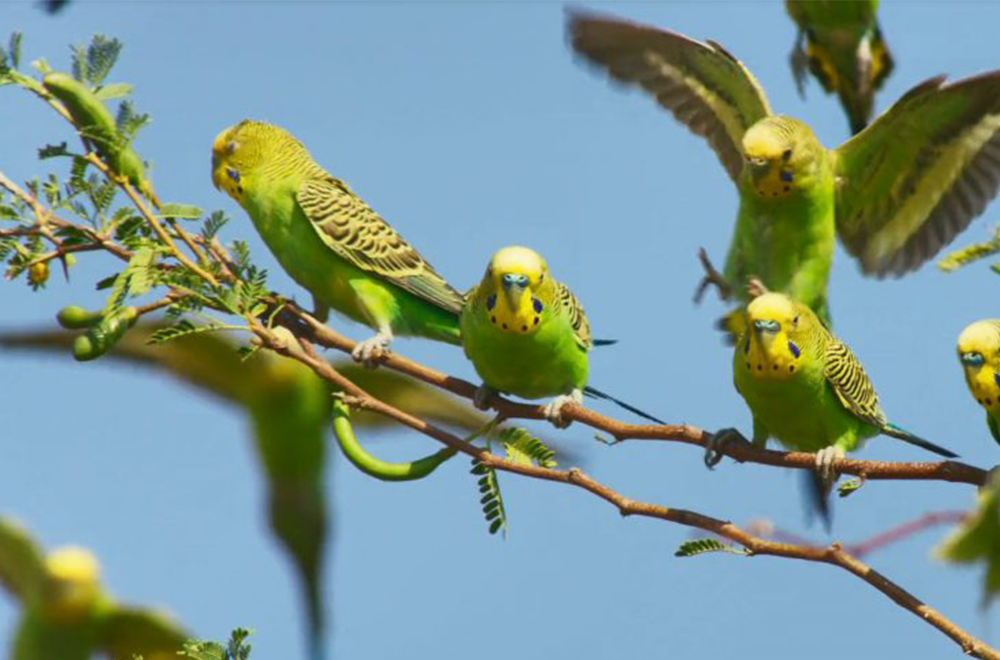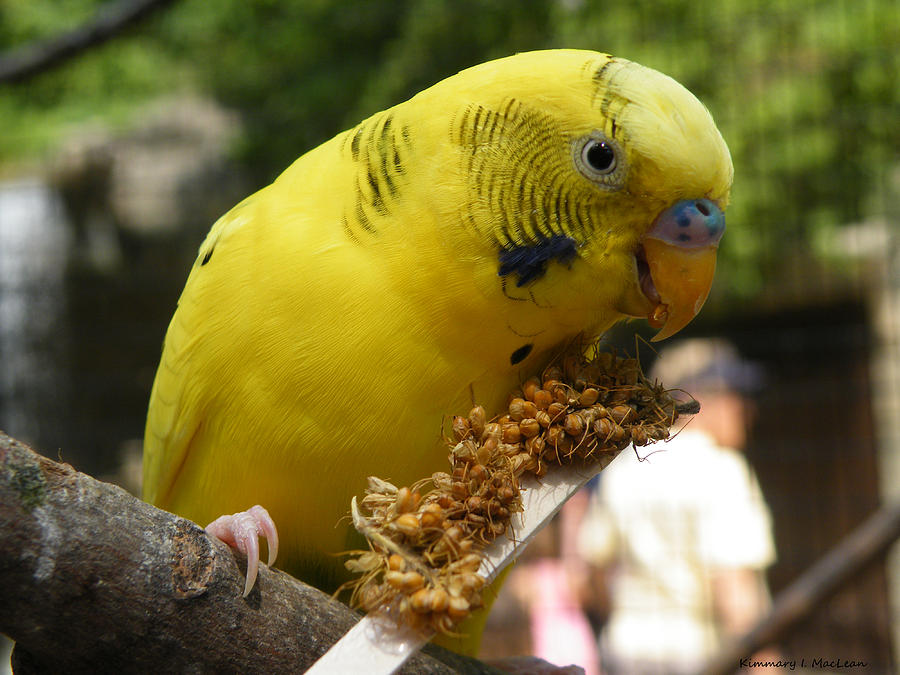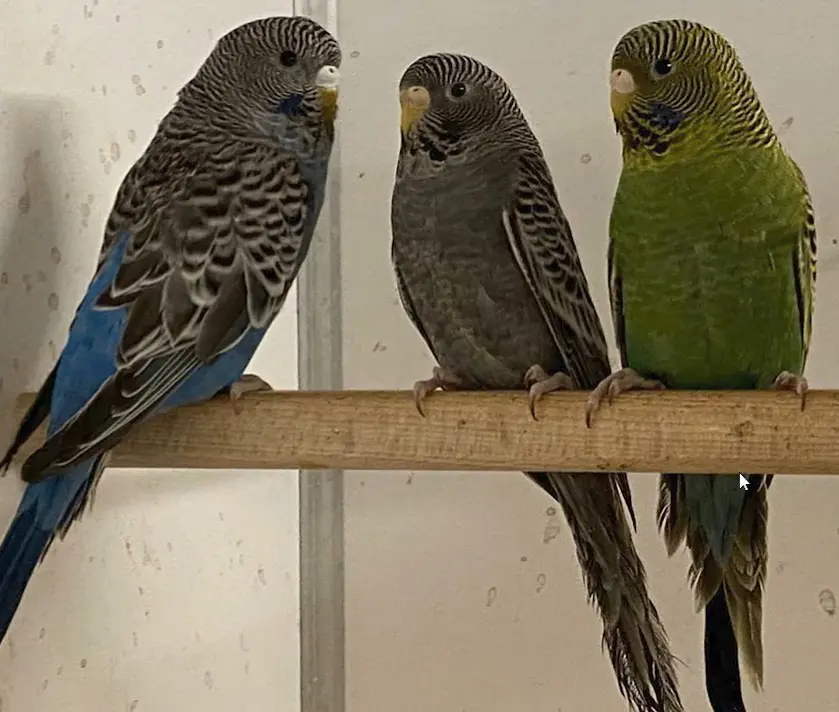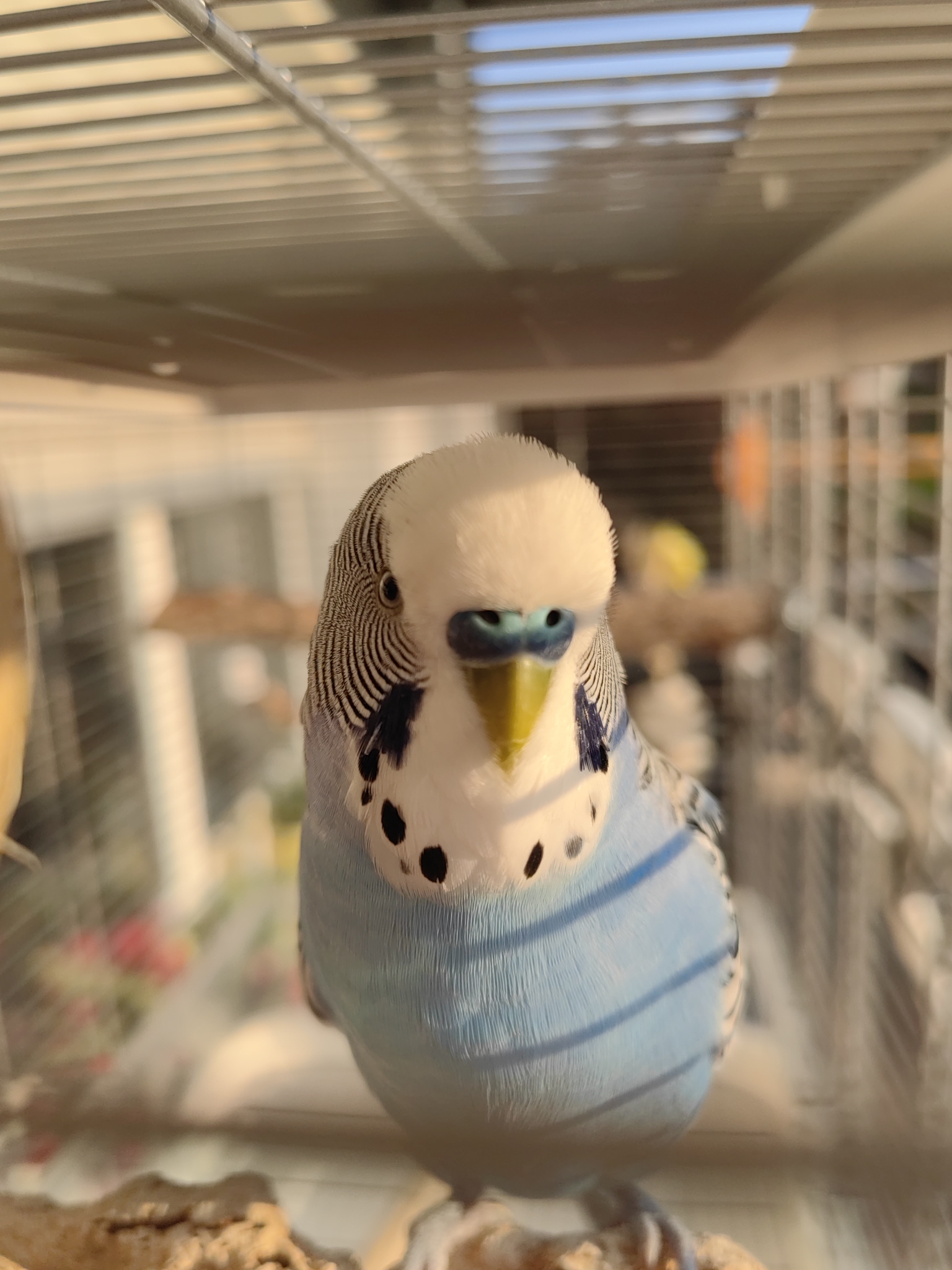Budgie Color Genetics
Budgies, also known as budgerigars or parakeets, come in a wide range of colors and mutations. These delightful birds are renowned for their vibrant plumage and charming personalities. Let's delve into the captivating world of budgie colors and explore the numerous variations you can find.
One of the most common and recognizable colors is the wild-type or green budgie. These budgies have bright green body with yellow feathers on their forehead, cheeks, and abdomen. They also possess black stripes on their wings, creating an attractive contrast. However, beyond the classic green, budgies exhibit a breathtaking array of color mutations.

Budgies in the wild.
Blue budgies are a popular variation characterized by their striking blue feathers. This mutation alters the pigment distribution, resulting in an enchanting shade of blue. Sky blue, cobalt, and navy blue are among the different shades you may encounter.

The yellow or lutino mutation produces budgies with beautiful, pale yellow plumage. These birds lack the typical melanin pigmentation, resulting in vibrant yellow feathers throughout their bodies. Their eyes are typically red or pink, creating a captivating contrast.
 Yellow budgie by: Kimmary MacLean.
Yellow budgie by: Kimmary MacLean.
If you come across a budgie with predominantly white feathers, it is likely an albino or white-faced budgie. These birds lack all pigmentation, resulting in a pure white appearance. Their eyes are usually pink or red due to the absence of melanin.
 Albino budgie by: Alia.
Albino budgie by: Alia.
Another remarkable color variation is the pied budgie, which exhibits a mosaic-like pattern. Pied budgies have patches of white or yellow feathers interspersed with their primary color, creating a unique and eye-catching effect.
 White blue pied budgie.
White blue pied budgie.
In addition to these basic colors, budgies can have a combination of multiple mutations, leading to even more variations. For instance, you may find a yellow-faced blue budgie, which combines the yellow mutation with the blue plumage. Other combinations include cinnamon, grey, violet, and spangle mutations, each adding its own distinct hue and pattern to the bird's appearance.
 Rare black-face budgies.
Rare black-face budgies.
The many color variations of budgerigars, such as albino, blue, cinnamon, clear-winged, the various fallows, grey, grey-green, grey-wing, lutino, mauve, olive, opaline, spangled, suffused, and violet are the result of mutations that have occurred within specific genes. According to Wikipedia, there are actually at least thirty-two known primary mutations established among budgerigars. These can combine to form hundreds of secondary mutations and color varieties which may or may not be stable. As is true with all animal species, color mutations occur in captivity as do in the wild. This has been demonstrated when captive-bred budgerigars have developed mutations that had only been previously recorded amongst wild populations.
 A "half-sider" budgie.
A "half-sider" budgie.
 Rainbow budgie babies.
Rainbow budgie babies.
Green is The Only "Natural" Budgie Color in The Wild
The natural color of a wild-type budgie, also known as the normal or green budgie, is predominantly green. Wild-type budgies have bright green bodies, with yellow feathers on their forehead, cheeks, and abdomen. They also have black stripes on their wings, creating a beautiful contrast against the green plumage. The green coloration provides excellent camouflage in their natural habitat, which consists of grasslands, forests, and scrublands in Australia, their native region.
In addition to the green body, wild-type budgies have a blue coloration on their rump and the flight feathers of their wings. This blue color is most visible when the bird is in flight or when the wings are spread. It adds an extra touch of vibrancy to their appearance. The wild-type coloration of budgies serves as a form of protection in the wild, allowing them to blend into the surrounding vegetation and avoid predators. It is essential for their survival and adaptation to their natural environment.
Why Do Color Mutations Happen in Budgies?
Budgie color mutations occur due to genetic variations that affect the distribution and expression of pigments in the bird's feathers. These mutations can arise naturally or be selectively bred by aviculturists to produce specific color variations. Let's explore the factors that contribute to budgie color mutations in detail.
Genetics plays a significant role in determining the color of a budgie. Budgies have two types of pigment that contribute to their feather colors: eumelanin, which produces black and grey colors, and psittacin, which produces yellow and red colors. The interaction and distribution of these pigments are regulated by various genes.
One of the most well-known genetic mutations in budgies is the blue mutation. This mutation affects the gene responsible for converting yellow pigments into blue pigments, resulting in a shift from green to blue coloration. The blue mutation reduces the amount of yellow pigment, resulting in a visually appealing blue hue.
 Hatchin being a cute blue boy.
Hatchin being a cute blue boy.
The yellow or lutino mutation is another common budgie color variation. This mutation affects the gene responsible for producing melanin, resulting in a reduction or absence of black and grey pigments. As a result, the bird's feathers appear predominantly yellow, with vibrant hues ranging from light yellow to deep golden shades.
Albino budgies are the product of a genetic mutation that prevents the production of any melanin pigment. This mutation affects the gene responsible for melanin synthesis, resulting in birds with pure white plumage and pink or red eyes. Albino budgies lack any color pigmentation, giving them an ethereal and striking appearance.
Other color mutations, such as cinnamon, grey, and violet, are the result of alterations in specific genes that affect the distribution and intensity of pigments. These mutations can cause changes in feather color, pattern, and intensity, leading to a wide variety of unique appearances.
Selective breeding practices have also contributed to the development of budgie color mutations. Aviculturists selectively breed birds with specific color traits to enhance and propagate those characteristics. Over time, this selective breeding has resulted in the creation of new color mutations and variations that might not naturally occur in the wild.
Note that budgie color mutations can occur spontaneously through genetic mutations or arise as a result of breeding programs designed to create new and unique color combinations. The complexity of the genetics underlying budgie coloration allows for a vast array of possibilities, giving rise to the diverse and captivating colors we observe in these delightful birds.
Genes responsible for pigment production and distribution can undergo changes, resulting in different color variations. Additionally, selective breeding by aviculturists has played a significant role in developing and refining the range of budgie color mutations available today. The interplay between genetics, mutations, and breeding practices has led to the mesmerizing palette of colors we admire in these charming birds.
Classifications of Mutations
Each of the thirty-two primary mutations belongs to one of the four basic groups of mutations classified in parrot species genetics:
- Albinism: where eumelanin is either partially or completely reduced in all body tissues and structures.
- Dilution: where eumelanin is partially reduced in only feathering.
- Leucism: where eumelanin is completely reduced from total or localized feathering.
- Melanism: where eumelanin is increased in the feathering.
Why Do Genetic Mutations Happen in Birds?
Genetic mutations can occur in birds for similar reasons as in other organisms. Birds, like all living beings, are susceptible to genetic mutations due to various factors and processes that affect their genetic material:
-
Natural Variation: Genetic mutations are a natural part of genetic variation within populations. Mutations can introduce new genetic traits or variations that contribute to the diversity of bird species. These mutations can occur spontaneously during DNA replication or as a result of errors in genetic recombination during sexual reproduction.
-
Environmental Factors: Environmental factors can influence the occurrence of genetic mutations in birds. Exposure to radiation, chemicals, pollutants, or certain viral infections can increase the likelihood of DNA damage or errors during DNA replication, leading to mutations. For example, certain chemicals found in polluted environments may act as mutagens and increase the mutation rate.
-
Inherited Mutations: Birds can inherit genetic mutations from their parents. If one or both parents carry a mutation in their germ cells (sperm or egg cells), there is a chance that the mutation will be passed on to their offspring. Inherited mutations can contribute to genetic diversity within bird populations and can lead to the development of new traits or variations.
-
Selective Breeding: In domesticated bird populations, such as those bred for specific traits or appearances, intentional selective breeding can lead to the occurrence of genetic mutations. Breeders may select individuals with certain mutations or desirable traits and breed them to perpetuate those traits in subsequent generations. Over time, this selective breeding can lead to the establishment of new mutations or color variations in domesticated bird populations.
-
Genetic Drift: Genetic drift is a random process that occurs in small populations, including certain bird populations. In small populations, chance events can have a disproportionate impact on the genetic makeup of the population. Genetic drift can lead to the fixation of certain mutations or the loss of others, contributing to genetic variation within bird populations.
Not all genetic mutations have significant effects or consequences for birds. Many mutations may be neutral, meaning they do not significantly alter the bird's traits or have any noticeable impact on its fitness or survival. However, some mutations can be advantageous, providing birds with adaptations that enhance their ability to survive and reproduce in specific environments.
In summary, genetic mutations in birds can occur due to natural variation, exposure to environmental factors, inheritance, selective breeding, and random genetic processes. These mutations contribute to the genetic diversity within bird populations and can lead to the emergence of new traits, variations, or adaptations over time.
.png) Genetic mutation example.
Genetic mutation example.
Unusual Budgie Color Mutations
Unusual budgie colors refer to color variations that deviate from the typical or common colors seen in wild-type or domesticated budgies. These colors can result from natural genetic mutations or selective breeding practices.
-
Lutino or Yellow: While lutino budgies are relatively common, their vibrant yellow plumage makes them stand out. Lutinos lack melanin pigmentation, resulting in a predominantly yellow or golden appearance throughout their bodies. Their eyes are typically red or pink.
-
Albino or White: Albino budgies lack all pigmentation, resulting in pure white plumage. They have pink or red eyes due to the absence of melanin. Albino budgies create a striking and ethereal visual impression.
-
Blue: While blue budgies are not as rare as some other color variations, their captivating blue plumage is still considered unusual compared to the common green color. Blue budgies have a reduced presence of yellow pigmentation, resulting in a blue hue ranging from sky blue to deep cobalt.
-
Violet: Violet budgies exhibit a purple or violet hue in their plumage. This color variation is the result of a genetic mutation that affects the distribution of pigments, creating a unique and eye-catching appearance.
-
Cinnamon: Cinnamon budgies have a warm brown or cinnamon coloration instead of the typical green. This variation arises from a mutation that affects the eumelanin pigment, resulting in a shift toward brownish tones.
-
Grey: Grey budgies have a lighter and more muted appearance compared to wild-type green. This color variation is the result of a mutation that affects the distribution and intensity of pigments, resulting in a more diluted and silvery plumage.
-
Opaline: Opaline budgies display a unique pattern where the feathers on their back and wings have a translucent or opalescent appearance. This pattern is the result of a genetic mutation that affects the arrangement and structure of feather barbs, creating an alluring iridescent effect.
-
Pied: Pied budgies exhibit a mosaic-like pattern with patches of white or yellow feathers interspersed with their primary color. This variation arises from a mutation that affects the pigmentation distribution, creating a visually striking and unique appearance.
.jpg) Budgie color variations.
Budgie color variations.
Budgie Feather Colour Change
If a budgie’s plumage changes color after it has reached adulthood, it is usually a sign of deficiency in the diet. An all-seed diet, for example, can be low in vitamin A, which makes the budgie’s feathers appear less bright. Make sure your birds are eating well, and the problem should solve itself.
Another cause may be a lack of cleanliness. If a budgie doesn’t regularly preen – i.e. clean its feathers – it will look faded, dusty, and generally messy. Provide your pet with water for personal hygiene – via wet salad leaves and herbs, or a budgie bath – and he will happily bathe and preen himself. The preening involves a careful beak-manicure of individual feathers, using an oil gland on the budgie’s rump to give a healthy, waterproof, oily sheen.
If your budgie is being bullied, plagued by parasites, or ill for any other reason, his colors may look duller or dirtier than usual. The only budgie type that actually changes color over the months as it molts is the Opaline, mentioned in the Pied Budgies section below.
The Drawbacks of Cross-Breeding in Budgies and Other Companion Birds
Creating color mutations, such as a lutino ring-necked parakeet, result in weaker birds with more health problems. According to G. Harrison, specific color mutations are less resistant to disease: "The popularity of cockatiel color mutations brings an increase in disease and unthriftiness. Lutinos (with reddish eyes) seem to have immune deficiencies and short lives, whereas pieds (such as this pied white-faced cockatiel with dark eyes) have fewer health problems. (Chapter 2, The Companion Bird, Clinical Avian Medicine and Surgery.)" Harrison also states that genetic problems are poorly described in birds, but with intense inbreeding, development of mutations, or conservation breeding efforts from an extremely limited gene pool, it is reasonable to assume that hereditary defects will become more common. Behavioral changes including depression, anorexia, anuria, oliguria, polyuria, polydipsia, feather picking over the synsacrum, self-mutilation, seizures, and others may be associated with renal disease and should be noted in the history.